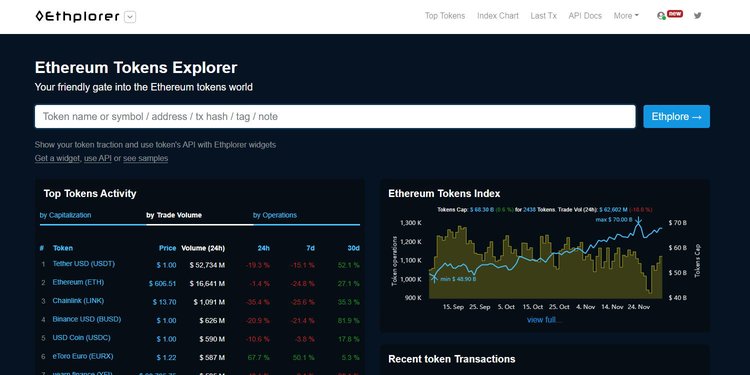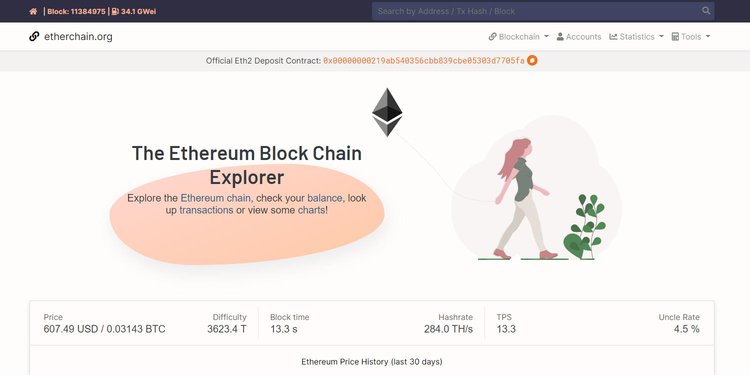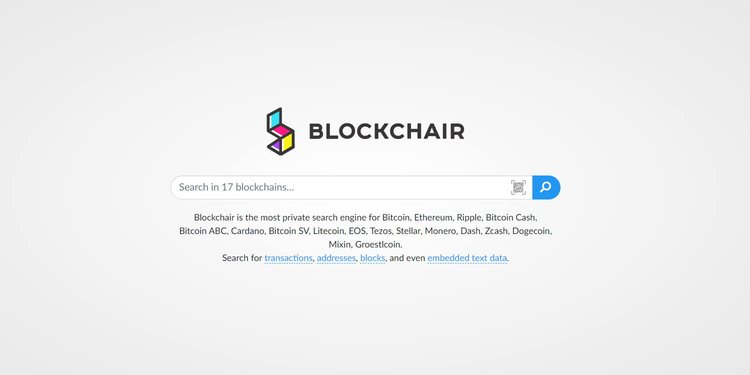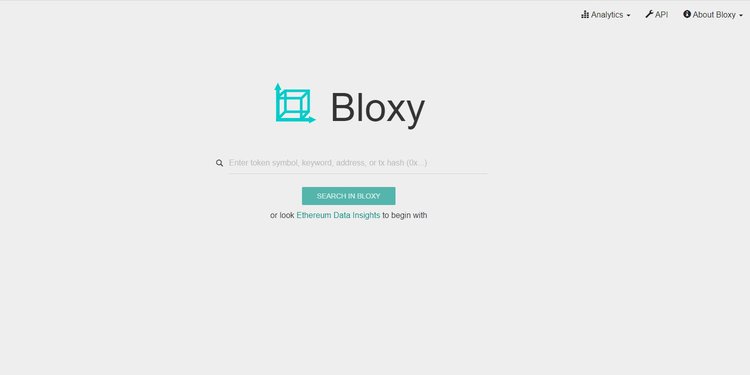Blockchain developers use on-chain data to build exciting products or further refine the base layer. A few examples of these products include exchanges, wallets, and portfolio trackers. Whenever a developer needs to monitor a large number of tokens or addresses, they utilize special portals known as blockchain explorers.
An explorer acts as a search engine for a blockchain, allowing developers to access real-time information such as block height, transaction count, amounts/balances and so forth.
Leading Ethereum explorers include:
Etherscan
This explorer supports searching for both ETH and Ethereum tokens.
Through the Etherscan Ethereum Developer APIs, data can be extracted through an API key without warranty for the data used. Their APIs are free to use, but capped at a rate limit of up to five calls per second, provided the user has a valid key.
There are nine APIs that developers can connect to - extracting data from the mainnet or from the Kovan test network.The Accounts API, for instance, can be used to explore the ETH balance for single or multiple addresses from a single call. Other than this, a list of normal transactions associated with a specific address can be retrieved in addition to other details a developer may require.
Developers can also verify and publish the contract source code. Once the code is uploaded, the Etherscan explorer will verify it, providing transparency for users interacting with the source code.
Essentially, this means the code can be audited by the public. To achieve this, the developer needs to submit a Constructor Argument specifically used for when the smart contract was being deployed. EtherScan will subsequently use this information to check if there are matches with the existing bytecode.
Additionally, developers with Etherscan accounts can add custom ABIs to smart contracts regardless of whether they were verified by the explorer. As such, there is a new way of interacting with and debugging smart contracts.
Developers can also use other tools to broadcast raw transactions, decode a low-level bytecode to opcode using their disassembler, or compile Vyper source code.
For developers tracking Eth2 Beacon Chain mainnet, Beaconscan is running and can be resourceful.
Ethplorer
This viewer focuses primarily on Ethereum tokens and is readying to become an Eth2 mainnet explorer. The Ethplorer API for developers can be used to target the mainnet or the Kovan testnet for information for token addresses and transaction history. They recently launched a new API panel for developers with an automated panel and keys for developers.
Ethplorer APIs are also convenient. Searches return information on tokens like name, decimals and their equivalent cost in USD, eliminating the need of extra requests, thereby simplifying development.
There is a "free key" that is unpersonalized and anonymous, enabling easy start and upload of working prototypes to GitHub without worrying about personal keys.
Still, for product projects, free personal keys with large limits of 10/second are suitable. Those who need more can upgrade and get a personal API key free of charge.
If a developer needs to track hundreds, thousands or even millions of addresses, they can use the new Bulk API Monitor. It is a unique tool that’s not offered by most explorers. For developers working on projects, there is a public tool kit enabling the running of working prototypes.
With this monitor, search pools can be created using a developer’s API key enabling the extraction of transactions for a list of addresses or tokens, or both. The Bulk API Monitor returns up to 10,000 transaction records in a single response.
Ethplorer also has a label and tag feature for data aggregation. Developers can use this feature to export data to CSV format. It is a tool with various use cases including tracking earnings and investment management.
A token or address of interest, for instance, can be searched, tracked and tagged from the viewer without signing up for an account. The tagging feature also comes in handy in pointing out scams or analyzing the behavior of "whales" for developers in the financial sector. Aggregated data is archived locally and later exported for analysis as a JSON file.
Etherchain
The viewer allows users to search for details about ETH and its tokens. It is built using Golang and uses a PostgreSQL database for storing and indexing network data.
However, there are no sophisticated tools for developers outside of their API services.
The Unit Converter eases conversion between different ETH units. The Gas Price Oracle uses the same model used by EthGasStation to estimate future Gas prices and has an API endpoint.
Additionally, the explorer has the Etherchain Light, a lightweight explorer for private Ethereum chains. It is built using NodeJS, Express and Parity, and doesn’t require any external database. Instead, the lightweight explorer retrieves all information directly from Ethereum nodes.
Etherchain Light is suitable for developers who want to build dApps on a private test net or would like to launch a private Ethereum chain and in need of an explorer for information retrieval. The explorer supports several features such as uploading and verification of contract sources, displaying the current state of verified contracts, displaying internal calls, and more.
Ahead of Eth2, Etherchain is preparing the Ethereum 2.0 explorer complete with a blockchain indexing engine. At this time, the underlying source code is still under development. Once ready, developers and network users can explore epochs, slots and other on-chain statistics. Additionally, validators can check their node performance using Etherchain resources.
Blockchair
They describe themselves as a "universal blockchain explorer and search engine."
Unlike the other services on our list, Blockchair allows users to extract information from Ethereum, Bitcoin and 15 other public chains using a single search box. Even so, their services are not as refined as specialized explorers, falling behind in some sections.
The Ethereum portal also offers Rest APIs with a free testing plan enabling developers to fetch JSON-formatted, real-time data from 17 blockchains supporting numerous SQL-like queries like filtering, sorting and aggregation of data with reliably high uptime. Almost all of their API endpoint descriptions are accompanied by an example visualization.
Developers who use their APIs occasionally will not require a key. However, academic and non-commercial projects constantly using their APIs will be required to apply for a free key. All commercial projects should apply for a premium key, giving them the latitude to extract more information from any of the supported blockchains. At the moment, their ERC-20 API is still in beta.
Additionally, they have a database dump feature, which can include blockchains and full nodes - downloadable in TSV format and updated daily.The project additionally possesses a node explorer. Through Blockchair APIs, developers can build a multi-currency wallet that can request transactions, addresses, xpub data and broadcast transactions. The site doesn’t collect user data other than for statistical purposes only.
Developers can also shift through the explorer’s public tracker of bugs, technical issues and questions via Github.
Blockchair continuously adds projects to their platform. Once added to the platform, Blockchair offers the project indefinite support. However, in order to qualify, the blockchain must be active with a high market cap.
Developers looking to extract data from Eth2 using this explorer have to reconsider. At the time of writing, they only have a glossary of Ethereum 2.0, tracking the latest deposits and top stakers with no complex tools to analyze the Beacon Chain mainnet.
Bloxy
This explorer provides advanced insights about transactions posted in Ethereum in real-time. For developers, the Bloxy APIs are complete with added metadata.
All of Bloxy’s analytical and reporting tools are connected to the database, and the explorer open, available on a personal basis. This means developers are free to retrieve data without spending more. However, the explorer’s creators have said their resources are limited. At the moment, priority is given to scientifically-based projects.
Their approach is based on mathematics and reliance on trusted data meaning blockchain developers can retrieve verifiable data that has no subjective external influence. Once extracted from a blockchain node, data is processed for it to be applicable in data mining, information retrieval, graphical analysis and other technologies relying on blockchain data.
Additionally, they have a number of graphs that make understanding the Ethereum blockchain easier. Their 18 API endpoints are categorized according to the data extractable for developer convenience. Specifically, SQL developers can make arbitrary queries through their search box.
For instance, the Token API helps developers analyze tokens and holders. Queries with quality demand of all levels and history depth can be searched, giving power and flexibility to the blockchain analyst or developer sifting data through their Bitquery.io.
On the other hand, the Addresses API is used for the analysis of addresses, activities and token statistics. The Bloxy API service can be accessed using any programming language or tool.
Bloxy have not announced any developer tool for Eth2 and the Phase 0 mainnet exploration.
Conclusion
Ethereum is open source and loaded with data available in several formats. It is also a collection of protocols and a foundation where developers can launch new dApps, protocols and smart contracts.
To do this, information needs to be extracted from blockchain explorers. These blockchain search engines all have interfaces where real-time data can be collected and filtered, while some also offer an API. Where a developer settles largely depends on the needs of their specific project.







